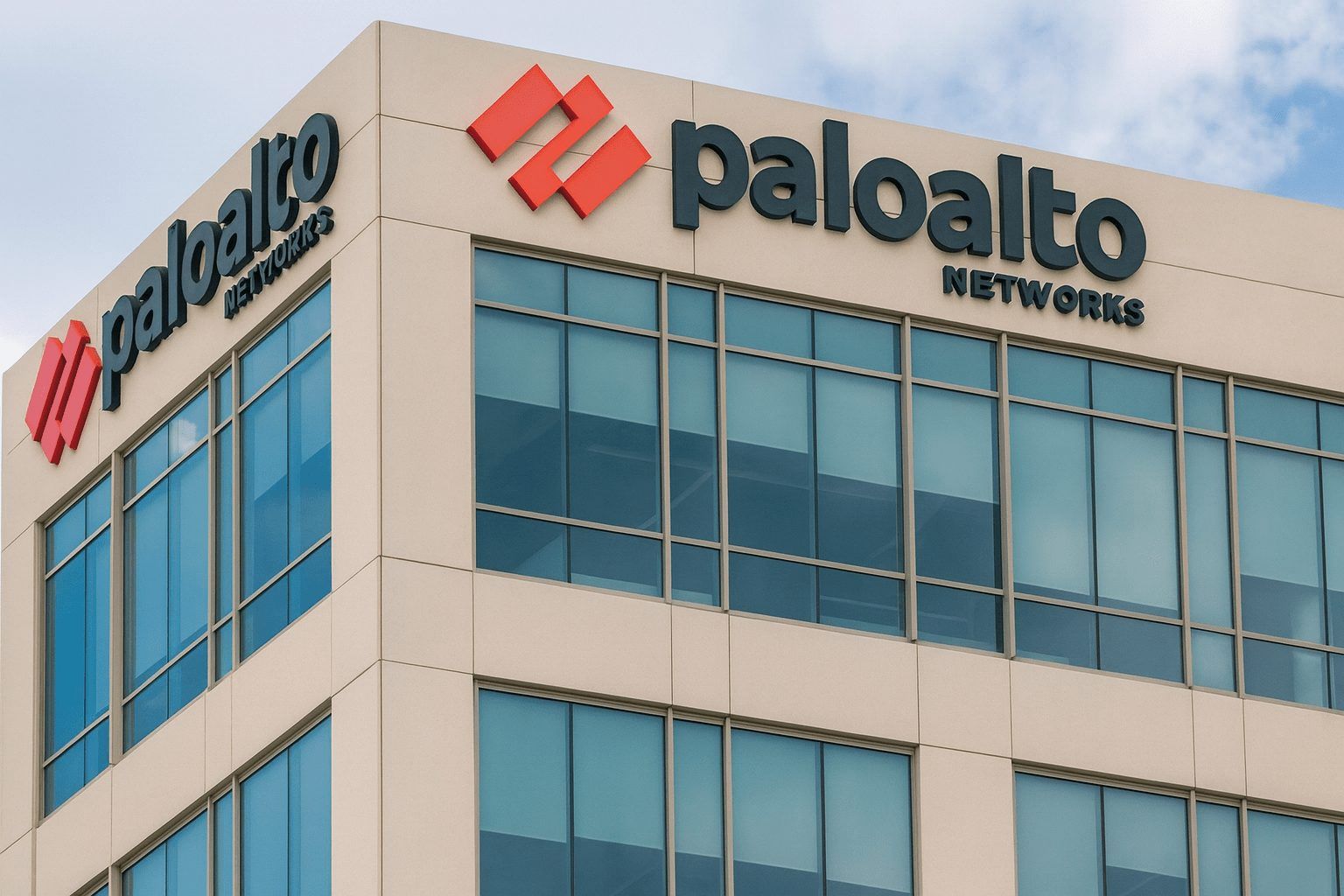Key takeaways
- PANW stock is trading around $182.90, down roughly 1.2% in the latest session and about 11% lower over the past five trading days, wiping out around $15 billion in market value. [1]
- The sell-off comes despite a fiscal Q1 2026 earnings beat, with adjusted EPS of $0.93 vs. $0.89 expected and revenue of $2.47 billion, up ~16% year over year. [2]
- Palo Alto Networks raised its full‑year fiscal 2026 guidance and is targeting revenue of $10.50–$10.54 billion and adjusted EPS of $3.80–$3.90, underscoring resilient cybersecurity demand. [3]
- The company announced a $3.35 billion acquisition of observability specialist Chronosphere, after previously agreeing to buy CyberArk for about $25 billion, doubling down on AI‑driven security and identity protection. [4]
- HSBC downgraded PANW to “Reduce” / “Moderate Sell” with a $157 price target, flagging high valuation and decelerating growth, even as the broader analyst consensus remains a Moderate Buy with an average price target around $225. [5]
- Recent filings show heavy insider selling, including CEO Nikesh Arora disposing of ~846,000 shares (~$173 million) in the last quarter. [6]
Palo Alto Networks stock price today (PANW) – November 22, 2025
As of the most recent trading data, Palo Alto Networks (NASDAQ: PANW) is changing hands at about $182.90 per share, down roughly $2.23 (about ‑1.2%) from the prior close.
Performance snapshot:
- 1 day: about ‑1.2%
- 5 days: about ‑10.9%, marking a five‑session losing streak
- 1 month (21 trading days): roughly ‑14.9%
- Year‑to‑date 2025: still modestly positive at ~+0.5%, versus about +12.3% for the S&P 500 over the same period. [7]
In other words, PANW has meaningfully underperformed the broader market in recent weeks, even though it remains slightly above where it started the year.
MarketBeat data pegs Palo Alto’s current market capitalization at around $125 billion, with a trailing P/E ratio near 116x and a PEG ratio around 4.4, underlining a premium valuation compared with many large‑cap tech peers. The stock’s 52‑week range runs from about $144 to $224 per share. [8]
Q1 FY 2026: Earnings beat, but growth is slowing from earlier years
Palo Alto Networks’ fiscal first quarter 2026 (quarter ended October 31, 2025) broadly beat Wall Street expectations:
- GAAP net income: about $334 million (roughly $0.47 per share)
- Non‑GAAP EPS:$0.93, topping consensus estimates of $0.89
- Revenue: about $2.47 billion, slightly above the $2.46 billion analysts were looking for and up around 15–16% year over year. [9]
The company continues to shift toward software and recurring revenue:
- Next‑Generation Security ARR (covering cloud, SASE and security operations) climbed to roughly $5.9 billion, up around 29% year over year. [10]
Guidance was also constructive:
- Q2 FY 2026 revenue: expected between $2.57–$2.59 billion,
- Q2 EPS (non‑GAAP): guided to $0.93–$0.95 per share,
- Full‑year FY 2026 revenue:$10.50–$10.54 billion,
- Full‑year EPS (non‑GAAP):$3.80–$3.90 per share. [11]
For a mature large‑cap name, mid‑teens revenue growth and expanding ARR are solid. However, investors have been conditioned to expect 20%+ top‑line growth from PANW, and the slowdown to the mid‑teens appears to be one reason the stock sold off following the report, despite the beat.
Looking back, Palo Alto generated about $8.0 billion in revenue in FY 2024 and $9.2 billion in FY 2025, with operating income rising from roughly $684 million to $1.2 billion over the same period, proof that the business is scaling profitably. [12]
Big strategic bet: Chronosphere and CyberArk deals
Two large acquisitions are now central to the Palo Alto Networks equity story:
Chronosphere: $3.35 billion push into observability and AI
On November 19, 2025, Palo Alto announced plans to acquire Chronosphere, a fast‑growing cloud observability and monitoring platform, for $3.35 billion in cash and stock. [13]
Key points:
- Chronosphere generated more than $160 million in annual recurring revenue (ARR) as of September 2025, meaning the purchase price implies almost 21x ARR. [14]
- Palo Alto intends to integrate Chronosphere with its Cortex AgentiX platform, using AI agents to automatically detect and investigate performance issues and security events across highly distributed cloud environments. [15]
- Management nudged up its fiscal 2026 revenue and EPS guidance alongside the deal announcement, arguing that Chronosphere will strengthen Palo Alto’s ability to secure AI‑native workloads and observability data at scale. [16]
While strategically attractive, the high multiple and deal size have raised concerns about integration risk and capital allocation, especially given the company’s already elevated valuation.
CyberArk: $25 billion identity security play
Chronosphere follows an even bigger step: Palo Alto’s previously announced plan to acquire CyberArk, a leader in privileged access and identity security, in a cash‑and‑stock transaction valued at about $25 billion. [17]
The CyberArk acquisition, expected to close in the second half of fiscal 2026, is aimed at turning Palo Alto into a full‑spectrum security platform, spanning:
- network security
- cloud and workload protection
- security operations and AI‑driven detection
- identity and privileged access management
Together, Chronosphere + CyberArk would further entrench Palo Alto as a consolidator in cybersecurity, but they also increase balance‑sheet and execution risk, a combination that can spook equity investors in the short term.
The AI and platformization narrative
Beyond M&A, Palo Alto has been busy shipping AI‑centric products:
- In late October, the company launched Cortex Cloud 2.0 and Prisma AIRS 2.0, updated versions of its cloud and AI application security platforms. [18]
- Prisma AIRS 2.0 incorporates technology from startup Protect AI, enabling end‑to‑end protection for AI applications, from development to deployment. [19]
- The Cortex AgentiX “agentic” AI platform is trained on 1.2 billion real‑world security incidents, designed to automate detection and response while retaining a “human‑in‑the‑loop” for oversight. [20]
On the business model side, Palo Alto has leaned hard into platformization—encouraging customers to consolidate multiple security tools onto its integrated platforms:
- Independent analysis of recent quarters highlights 90+ net new large platformization deals in Q4 2025, a low‑to‑mid‑30% growth rate in Next‑Generation Security ARR (to roughly $5.6–$5.9 billion), and AI‑related ARR now around $400 million. [21]
- Management has outlined a long‑term target of roughly $20 billion in ARR by fiscal 2030, built on AI, cloud, and—longer term—emerging themes like quantum‑resilient security. [22]
This platform + AI strategy is what many bullish analysts point to when they argue that Palo Alto’s premium valuation could be justified by sustained double‑digit growth and expanding margins.
So why is PANW stock falling?
Despite all the positives, PANW has been under heavy pressure in November. Several factors appear to be converging:
1. Valuation and HSBC downgrade
After a strong multi‑year run—2023 alone saw the stock climb over 100%—Palo Alto trades at a trailing P/E above 115x and a P/S ratio comfortably in the low‑teens, even after the recent pullback. [23]
On November 21, HSBC downgraded PANW from “Hold” to “Reduce” (effectively a sell rating), reiterating a $157 price target and citing concerns around valuation and decelerating growth. [24]
The downgrade added fuel to the sell‑off, reinforcing a narrative that expectations may have run ahead of fundamentals, especially with two large acquisitions on the table.
2. Insider selling
MarketBeat and other trackers highlight significant insider selling in recent months:
- CEO Nikesh Arora sold roughly 846,000 shares, worth around $172.7 million, reducing his stake by about 75%.
- In total, insiders disposed of around 1.2 million shares, worth roughly $249 million, in the last quarter. [25]
Insider selling doesn’t automatically mean trouble—executives diversify or exercise options all the time—but the scale and timing, coming alongside rich valuations and big M&A, have not gone unnoticed by investors.
3. Slower—but still strong—growth
While fiscal Q1 2026 growth in the mid‑teens is solid, it is slower than the 20–30%+ growth rates Palo Alto was posting in earlier years. Trefis notes that although revenue grew to $9.2 billion in FY 2025, year‑over‑year growth has moderated from earlier highs. [26]
At a time when the stock carries a high‑growth multiple, even a small deceleration can trigger a reset in expectations—and therefore in price.
What Wall Street is saying about PANW now
Despite the HSBC downgrade, most analysts remain constructive:
- According to MarketBeat, the overall rating on PANW is “Moderate Buy”, with 30 Buy ratings, 9 Hold and only 2 Sell, and an average price target around $225 per share—roughly 20–25% upside from current levels. [27]
- Evercore ISI’s Peter Levine recently raised his price target from $220 to $250, reiterating an Outperform rating and calling the recent pullback a buying opportunity given strong execution and platform adoption. [28]
In short, Wall Street is split between valuation skeptics and growth optimists:
- Bears worry about high multiples, slower growth, and integration risk from the Chronosphere and CyberArk deals. [29]
- Bulls focus on structural cybersecurity demand, platformization, AI monetisation, and long‑term ARR targets that could support continued double‑digit growth. [30]
Key metrics investors are watching today
For readers tracking Palo Alto Networks on November 22, 2025, these are some of the numbers likely on the dashboard:
- Share price: ~$182.90
- Market cap: ~$125 billion [31]
- Trailing P/E: ~116x
- PEG ratio: ~4.4 (implying a rich price relative to expected growth) [32]
- FY 2025 revenue: ~$9.2 billion, up from $8.0 billion in FY 2024 [33]
- Q1 FY 2026 revenue:$2.47 billion, up ~16% YoY
- Next‑Gen Security ARR: ~$5.9 billion, up ~29% YoY [34]
- Full‑year FY 2026 guidance: revenue $10.50–$10.54 billion, non‑GAAP EPS $3.80–$3.90 [35]
What to watch next for PANW stock
For investors and traders watching Palo Alto Networks stock today, several catalysts could influence where the shares head next:
- Regulatory progress and integration updates
- Any developments on closing the Chronosphere and CyberArk deals—and management’s commentary on integration plans and cost synergies—will be closely scrutinized. [36]
- AI product adoption and monetisation
- Uptake of Cortex AgentiX, Cortex Cloud 2.0, and Prisma AIRS 2.0 will be key indicators of whether Palo Alto’s AI bets are translating into incremental ARR and higher wallet share. [37]
- Macro IT spending and cyberthreat environment
- Security spending has stayed resilient even as other IT budgets face scrutiny, driven by nation‑state threats, ransomware, and AI‑enabled attacks—any change in that trend could help or hurt PANW’s growth trajectory. [38]
- Further analyst moves and sentiment shifts
- Additional downgrades or target cuts could extend the current slide, while renewed upgrades or target hikes—especially if backed by strong ARR metrics—could underpin a recovery. [39]
Bottom line: How to read Palo Alto Networks stock today
On November 22, 2025, Palo Alto Networks sits at the crossroads of strong fundamentals and fragile sentiment:
- Operationally, the company is delivering double‑digit revenue growth, expanding ARR, and robust cash generation, while positioning itself at the heart of AI‑driven and identity‑centric security. [40]
- Strategically, the Chronosphere and CyberArk acquisitions could cement Palo Alto as the default cybersecurity platform for large enterprises—if integration goes smoothly and the company avoids overpaying in hindsight. [41]
- But the stock’s high valuation, slower growth vs. prior years, fresh downgrades, and sizable insider selling have created a perfect storm for a pullback, leading to the current five‑day, 11% slide. [42]
For now, PANW is a classic “high‑quality but high‑expectation” story. Bulls and bears can both find plenty of ammunition in the numbers. How the stock trades from here will likely depend on:
- whether AI and platformization continue to power mid‑teens (or better) growth, and
- whether investors remain willing to pay a premium multiple for that growth in a market increasingly focused on valuation discipline.
Disclaimer: This article is for information and news purposes only and does not constitute financial advice, investment recommendation, or an offer to buy or sell any securities. Always do your own research and consider speaking with a licensed financial adviser before making investment decisions.
References
1. www.trefis.com, 2. www.timesunion.com, 3. www.reuters.com, 4. www.reuters.com, 5. www.investing.com, 6. www.marketbeat.com, 7. www.trefis.com, 8. www.marketbeat.com, 9. www.timesunion.com, 10. investors.paloaltonetworks.com, 11. www.timesunion.com, 12. www.trefis.com, 13. www.reuters.com, 14. www.reuters.com, 15. www.reuters.com, 16. www.reuters.com, 17. apnews.com, 18. www.reuters.com, 19. www.reuters.com, 20. www.reuters.com, 21. www.ainvest.com, 22. seekingalpha.com, 23. www.trefis.com, 24. www.investing.com, 25. www.marketbeat.com, 26. www.trefis.com, 27. www.marketbeat.com, 28. www.barrons.com, 29. www.tipranks.com, 30. www.ainvest.com, 31. www.marketbeat.com, 32. www.marketbeat.com, 33. www.trefis.com, 34. investors.paloaltonetworks.com, 35. www.reuters.com, 36. www.reuters.com, 37. www.reuters.com, 38. www.reuters.com, 39. www.tipranks.com, 40. www.timesunion.com, 41. www.reuters.com, 42. www.trefis.com







